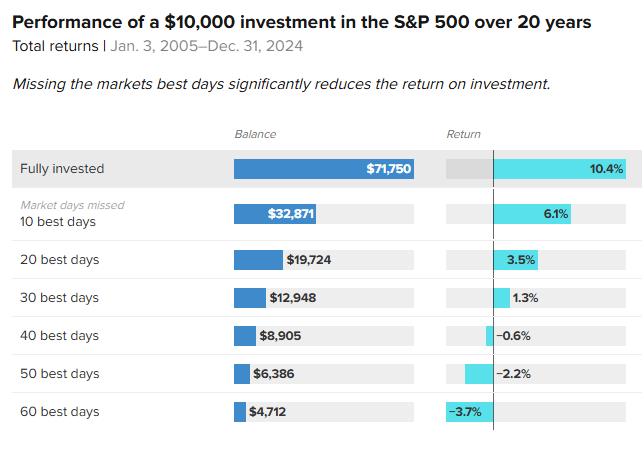What a 12% Nasdaq day teaches us about long-term investing
Charu Chanana
Chief Investment Strategist
Key points:
- Markets move fast—missing just a few of the best days can dramatically cut your long-term returns. A single rally day like Wednesday can make a huge difference.
- While the recent bounce is encouraging, it may not last. Trade tensions, inflation concerns, and Fed policy remain key headwinds.
- Trying to time the market is risky and often counterproductive. Long-term investors are better served by staying invested through uncertainty.
It finally happened. After weeks of relentless red screens and investor nerves stretched thin, Wall Street got a major jolt of relief—and it was a big one. The Nasdaq surged 12% in a single day. The S&P 500 rallied nearly 10%. Even the battered Dow saw a 7.9% comeback.
Tech was the undisputed leader, with Nvidia up 19%, Tesla popping 23%, and Apple adding 15% in a flash. The rally followed a surprise policy move by President Trump, who announced a 90-day pause on the harshest new tariffs—for countries that hadn’t retaliated against the U.S. Investors had been bracing for a deeper economic hit from escalating trade tensions, so the temporary truce sparked a massive wave of buying.
But beyond the headlines, yesterday’s rally sent a powerful message: this is why staying invested matters.
Missing the best days can cost you, significantly
Market timing sounds good in theory. In reality? It’s incredibly hard to do. Selling during downturns can protect capital in the moment, but it risks missing the exact days that drive long-term returns.
Historically, just a handful of the market’s best days each year account for the lion’s share of long-term returns. Miss them, and you could drastically undercut your portfolio’s performance.
Let’s say you sold earlier this week to “wait out the volatility.” It’s totally understandable—but it would’ve meant sitting out one of the strongest one-day rallies in history.
Why this day mattered more than most
Yes, the news was significant. But the bigger story is what this kind of day tells us about investing: you need to be in the market to benefit from days like this.
The JP Morgan chart below shows the steep cost of missing just a few key days—even over a 20-year horizon.

Source: JP Morgan Asset Management
- If you stayed fully invested, that $10,000 grew to $71,750 (10.4% annual return).
- Miss just the 10 best days? You’re down to $32,871.
- Miss 30 best days? You’re barely ahead at $12,948.
- Miss 60 best days? You lost money—ending with just $4,712 (-3.7%).
Many of those "best days" come right after the worst. Just like Wednesday.
Tariffs, tech, and turnarounds
The market has been under pressure for weeks as tariffs between the U.S. and China escalated. Tech, in particular, took it on the chin. But Wednesday’s surge showed just how quickly sentiment can shift. Investors didn’t need all the uncertainty to go away—they just needed a little less bad news.
And here’s the kicker: Trump also announced a steep 125% tariff on China the same day. So yes, risks remain, and this rally may prove short-lived.
But markets looked past the negatives and seized on any hint of progress. That’s how bottoms often form: quietly, amid a fog of bad news, and when few expect it.
What should investors do now?
Trade tensions are still high, inflation risks remain, and the Fed isn’t in a rush to cut rates.
But if you’re investing with a multi-year lens, this week was your reminder: staying calm, consistent, and committed matters more than ever. You don’t need to time the bottom—you just need to be there when it happens.
Consider these strategies:
- Stay diversified: Yesterday’s rally was broad, but tech led the way. Maintaining a mix of growth, value, and defensive sectors helps you participate when leadership shifts.
- Review your time horizon: If you’re investing for years, not days, short-term volatility shouldn’t derail your plan.
- Use volatility to your advantage: For active investors, pullbacks are opportunities to add to quality names.
- Consider dollar-cost averaging: Especially during volatility, adding gradually can help you avoid buying at peaks and benefit from dips.
- Stay informed, not reactive: Headlines move markets fast—but your strategy should be built to outlast the news cycle.

